The Triplets of Belleville
[DVD]
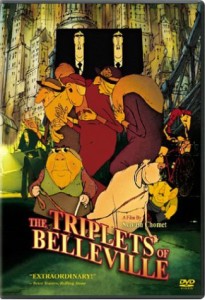
view/request
Sylvain Chomet’s feature-length animated film is like nothing you’ve ever seen. It’s weird, funny, sad, serious, lighthearted, suspenseful, perverse, sweet, surreal, retro, postmodern, and fantastic (in both senses of the word). There is virtually no dialogue, but there is music, adventure and character aplenty. The animation is hand-drawn and loaded with sophisticated detail. There are homages to Fred Astaire, Josephine Baker, Jacques Tati, the Andrews Sisters, and Django Reinhardt. The plot is quite satisfying, yet the style is the overwhelming story here. Despite the near-total absence of language, it could only be French. I have seen it three times so far and haven’t begun to get tired of it.
Reviewed by Faith
Tagged: Animation, Feature film, Foreign film
The story of Vernon and Irene Castle
[DVD]
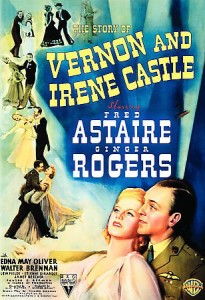
view/request
Based upon the true story of the celebrated husband and wife dancing team who popularized ballroom dance, this film is the most realistic, the most tragic, and the most touching of the Astaire-Rogers films. The film takes place in the years between 1911 and 1918, and the costumes and music are largely appropriate to that era. Most of the dance sequences emulate the Castle’s distinctive style—Astaire tap dances in only one number and Rogers not at all—and the musical numbers are fewer and more tightly integrated into the plot than in other Astaire films. Of course, the film still delivers what you expect from an Astaire-Rogers collaboration: Astaire is charming, the music is great, the dancing better, and the two stars may have better on-screen chemistry in this film than in any other.
Reviewed by Ben
Tagged: Comedy, Dance, Drama, Feature film
The Purple Rose of Cairo
[DVD]
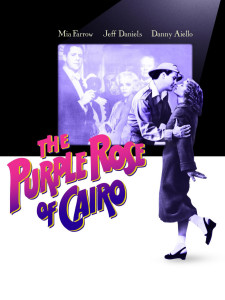
view/request
“You make love without fading out?” – Tom Baxter
The Purple Rose of Cairo is possibly my favorite Woody Allen film of all time… or perhaps tied with a couple other of his classics. In it we have some of his sharpest comedic screenwriting and a few concepts that will keep philosophy 101 students in discussion for decades to come.
It stars Mia Farrow as Cecilia, a woman struggling to support herself and her abusive, gambling and out of work husband (played by Danny Aiello) during the great depression. Her only escape from this drudgery is regular visits to the local cinema. When the lights dim, she gets whisked away in stories of adventure, romance and carefree living.
She particularly is enamored with the film the Purple Rose of Cairo (the film within our film!). Cecilia makes repeated trips to catch the Purple Rose and watches the story of bubbly society folk on an Egyptian expedition. After several viewings, she starts to notice slight inconsistencies with one of the character’s performance. Tom Baxter, played by Jeff Daniels, seems to be losing his timing and is possibly looking off into the audience. Eventually, he breaks character and talks to Cecilia from the screen. She nervously replies and Baxter walks out of the film and materializes in the theater.
The two dash off in a heap of commotion and the ex-film character appears to be the ideal romantic partner despite naïveté in real world dealings. His knowledge base consists of what was written for his character. For example, when dining, the couple are embarrassed to discover that Baxter’s cash supply is simply prop money.
Eventually, a surreal love triangle… or better yet, love square forms. When Gil Shepherd (also played by Jeff Daniels), the actor who portrayed Baxter, discovers that his character has left the film, he heads to New Jersey to convince his creation to re-enter The Purple Rose of Cairo. Whilst attempting to salvage his reputation and make everything go back to normal, Shepherd then falls for our leading lady. Does Cecilia leave her husband? Does she run off with the brave and compassionate, but fictional Tom Baxter? Or does she chose Gil Shepherd, the dashing and vain movie star?
Reviewed by Jason
Tagged: Comedy, Feature film
Histoire de Melody Nelson
by Serge Gainsbourg
[Music CD]
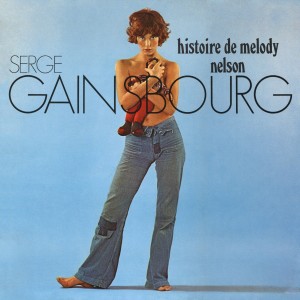
view/request
The master melodist and provocateur, Serge Gainsbourg introduced a revolutionary recording with 1971’s Histoire de Melody Nelson. The French pop star abandoned an archetypal singing style in place of a soft and nearly spoken word delivery. This was achieved by the singer’s smokey, baritone voice captured by close microphone placement. The music behind this voice is expressive and experimental with shades of psychedelia. Groovy (and yes, there’s really no other way of putting it) electric bass lines, freak out fuzz guitar and busy drums supply the basic tracks that are augmented by a choral and haunting string score by Jean-Claude Vannier.
Jane Birkin, Gainsbourg’s then wife, appears on the front cover and also provides the voice of Melody Nelson. You see, this is a concept record. It tells a Lolita-esque tale of a middle-aged man out driving who accidentally hits a bicycling British girl. The man falls in love with his victim and a love affair follows. Melody soon decides to fly home and the man, now devastated, performs an African Cargo Cult ritual to make his love return. His desperation proves to be tragic as he discovers that this act of mysticism caused an airplane crash.
The songs of Serge Gainsbourg, and the Melody Nelson album in particular, have inspired many musicians including Air, Jarvis Cocker, Beck, Portishead, Sean Lennon and the Divine Comedy. Rarely has the marriage of lyrical ingenuity and musical arrangement been achieved in popular music.
Reviewed by Jason
Tagged: French language, World music
The Ditty Bops
by The Ditty Bops
[Music CD]
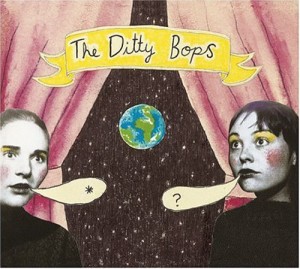
view/request
I enjoyed this band so much the first time I heard them (live, at Pearl Street) that I bought five copies of their self-titled album; I kept one copy for myself and gave the rest as Christmas gifts. This is fun music. Amanda Barret and Abby DeWald excel at quirky lyrics and tight vocal harmonies, and these two very competent musicians (in addition to their fine singing Abby plays guitar and Amanda plays mandolin and dulcimer) are backed up by an excellent band that really knows how to swing. They play in a variety of styles; swing, blues, and ragtime are among their more obvious influences.
I love the sound of this album, but I also love the words to many of the songs. The lyrics can change from nonsensical, to mundane, to profound all in the course of a song, and a song like “Walk or Ride” does all of these while addressing an issue that is dear to my heart.
Reviewed by Ben
Tagged: Folk music
The Red Shoes
[DVD]
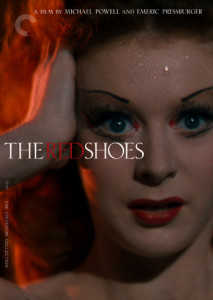
view/request
The Red Shoes is a visually stunning dramatic work about a ballet company led by the ruthless and contentious, but often charming director Boris Lermontov. Lermontov discovers dancer Vicky Page (portrayed by famed English ballet star Moira Shearer) at a society party and realizes her unparalleled potential. Before signing her to his company she must decide what role dancing plays in her life. Is it a passion she pursues or shall it consume her entirely? Can an artist love anything or anyone more than their craft? These conflicts becomes the underlying theme of the picture.
The Hans Christian Andersen story of The Red Shoes is the source in which the main ballet within the film is based. Instead of just viewing the performance from the theater audience’s perspective, Powell and Pressburger take the camera’s inside the action for a breathtaking, 17-minute sequence. We follow Page closely via dolly shots through various enormous, painted set pieces, close-ups of dancers movements and expressions and rich colored lights. The co-directors also chose to allow fantasy to be a part of the stage presentation as well with tasteful in camera visual effects.
The Red Shoes, which melodrama and beauty reach unbelievable heights, is a remarkable achievement in cinema.
Reviewed by Jason
Tagged: Ballet, Drama, Feature film
Spooked
by Robyn Hitchcock
[Music CD]
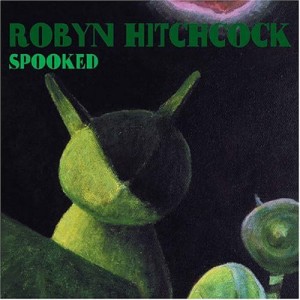
view/request
In 2004, Robyn Hitchcock recorded one of his finest albums with folkster heroes Gilllian Welch and David Rawlings. The trio set up shop in Nashville, TN and created this very sparse and absorbing recording. The album is filled with rich textured harmonies, picking acoustic guitars and a refreshing amount of open space. Though mostly an acoustic record, the album also features spots of electric piano, minimal drums, electric sitar for psychedelic touches and Eastern flavor and a couple electric bass guest spots by NRBQ man Joey Spampinato.
On the dobro led “We’re Gonna Live in the Trees”, Hitchcock’s famed clever lyrics bounce the literary reference of Virginia Woolf had a troubled mind, it was never at ease with the song’s title/refrain. He also shows a softer side with the slow and outer-spacey “English Girl”. Her skin was clear and her mum wore pearls/I fell in love with an English girl/ She asked me for an almond whirl/ I was obliged to the English girl.
Robyn Hitchcock is one of the few recording artists whose catalog has remained consistently inspired throughout a lengthy career. Spooked, in particular, stands out from his recent output due to the stunning contributions from Welch and Rawlings.
Reviewed by Jason
Tagged: Folk music, Music, Psychedelic, Rock music
Head
by Bob Rafelson
[DVD]
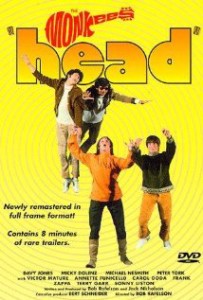
view/request
Head is a psychedelic, non-linear motion picture starring… THE MONKEES. While not participating in a traditional narrative, the film retains a cyclical structure. Cyclical, in this instance, by that one can take nearly any scene, rearrange it and the action will still relate and have meaning in its new place. Bob Rafelson, a co-creator of the Monkees television series, made his feature directorial debut with 1968’s Head. He co-wrote the film with the then obscure Roger Corman school B-movie actor Jack Nicholson.
Rafelson and Nicholson sought to tell the Monkees story and the complexities of instant fame in an abstract fashion while also exploiting as many genres as possible. It poses the question, “well, what is Head?” A musical? A western? A horror film? A comedy? A boxing story? A Vietnam war protest? A sprawling adventure film? It’s safe to say these are all correct answers. The director uses esoteric dialog and cutting edge technology (i.e. the process of coloring film… which was essentially only explored in avante-guarde cinema up until this time) to collect these disparate elements and house them in a single story.
What also works in this film’s favor is that we have a collection of some of the Monkees best recorded material. Mickey Dolenz sings two lazing and beautiful Carole King compositions along with the Eastern flavored “Can You Dig It”, a song by Monkey Peter Tork. Peter’s other writing credit comes with the groovy freakout “Long Title: Do I Have to Do This All Over Again”. Davy Jones performs a dance scene with Toni Basil while singing Harry Nilsson’s Tin Pan Alley inspired “Daddy’s Song”. Michael Nesmith writes and sings “Circle Sky”, what we shall only consider as a psychedelic, ramshackle ho-down.
Although, in 1968 the film proved to be an immense commercial failure, Head has become a cult classic and an excellent artifact in the colored history of the Monkees. Rafelson continued his maverick approach to cinema and is now considered one of the most revered directors and producers of the “New Hollywood” generation.
Reviewed by Jason
Tagged: Comedy, Feature film, Musicals
Two Escobars
[DVD]

view/request
This riveting documentary film was made by Northampton natives Jeff and Michael Zimbalist as part of the excellent ESPN 30 for 30 series. It examines a harrowing period in Colombia’s history when rival drug cartels were warring in the streets and the national soccer team set out to win the world cup and by extension, create a new positive image for their country. The Two Escobars of the title are Andres Escobar, the softspoken but inspiring captain of the National Team, and Pablo Escobar, who was a notorious cartel leader and brutal drug baron, but also a team owner and folk hero to many poor people in Colombia. The documentary takes a clear eyed look at a period of Colombian soccer and society which stretched from the height of the phenomenon known as “Narco-Soccer” through their ignominious and ultimately tragic loss in the first round of the 1994 World Cup. Like many of the 30 for 30 series filmmakers, the directors succeed in showing the importance and influence of sport on society as a whole, how it reflects and is influenced by the best and worst aspects of our culture. As a result the film appeals to viewers who are not die-hard sports fans, ‘soccer’ fans or familiar with World Cup Football. One of the best of the ESPN 30 for 30 series and best documentaries of 2010, it was an Official Selection at the Cannes, Tribeca and Los Angeles Film Festivals.
Reviewed by Dylan
Tagged: Colombia, Documentary, Soccer
Fish Tank
[DVD]
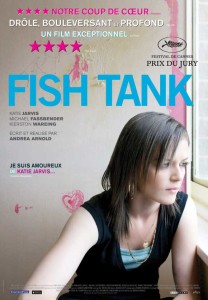
view/request
This Cannes Jury Prize award winning indie film from British Director Andrea Arnold captures an English ‘Coming-of-Age’ tale far from the stereotypical pastoral village green. Set in a bleak Essex council estate, the films energy and success is derived mainly from the talented young lead, Katie Jarvis. Jarvis was discovered yelling at her boyfriend across platforms at a local train station by the casting director after numerous unsuccessful auditions for the role by better known and established actresses. The film centers on the adolescent conflicts of her character (Mia) and her discovery of dance as an escape and outlet from fights with her family and peers. Unlike so many dance related films, Arnold wisely avoids the typical clichés of the genre, with no dance-offs, miraculous improvements in skill overnight or extended montages showing a sudden rise to fame. Instead Mia’s dancing is shown for what it is, a creative outlet and escape rather than a possible career choice. Without laboring the point, the film contrasts Mia’s love of and desire to learn the basic skills of ‘break-dancing’ with the hyper-sexualized dance moves of her peers, who are plainly mimicking popular music videos. The introduction of her mother’s new Irish boyfriend (played by rising heart throb Michael Fassbender) expands and ultimately threatens Mia’s fragile world . His influence on Mia and her selfish and neglectful mother and charming and foul mouthed little sister is, by turns, both inspiring and disturbing. Arnold, who won an Oscar in 2003 for her short film Wasp, directs the film with a skilled hand, anchoring it in social realism without wallowing in cliché or misery. It is decidedly not a light hearted family film but also not without hope or joy.
Reviewed by Dylan
Tagged: England, Feature film
Now
by Bhagavan Das
[Music CD]
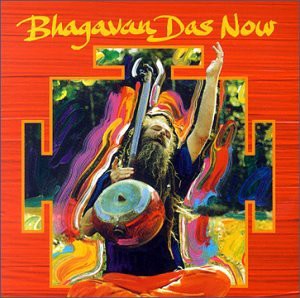
view/request
This is a very interesting recording. Bhagavan Das sings traditional kirtans and bhajans, or devotional songs, from India, and his performance shows his deep familiarity with these traditions while simultaneously embracing a very modern sound. This is in part due to Das’ collaboration with the album’s producer, Mike D of the Beastie Boys, who contributed samples and loops which give the album a very modern feel, but don’t, perhaps surprisingly, feel the least bit out of place. In addition, Das is accompanied by a wide range of musicains playing instruments from the east and from the west, traditional and modern. We hear guitars and ektar, drum sets and tabla, sarangi and synthesizers, harmoniums, organs, and conch shells. We can also hear the influence of the blues, the Beatles, and traditional Indian singing styles.
Every track on this album is powerful, energetic, and alive. Every word is heartfelt. I’ve only had a chance to listen to this album once so far—but I’m very much looking forward to listening to it again.
Reviewed by Ben
Tagged: Hip-Hop, Religion, Yoga
Exit through the Gift Shop
[DVD]

view/request
What starts off somewhat conventionally as a documentary on street art culture and its biggest legend and mystery Banksy, is flipped into an scathing satire of the art world. The film, ostensibly created by and starring Banksy, Shepard Fairey and the ‘amateur documentarian’ Thierry Guetta , is a priceless document/depiction of street art’s journey indoors and its eventual corruption at the hands of those who seek to document, celebrate and endorse it. The films ability to keep the viewer questioning the authenticity and the reliability of the films guide/narrator/director, Thierry, cleverly parallels the art world’s desperate quest to identify Banksy and to own and define his work. In capturing both the rush and excitement of the creation of ‘street art’ and the vacuous dullness of those who seek to commodify and blandly reproduce it, Banksy has created an enthralling portrait of what happens when the lines between art and commerce, public spaces and private property, and documentary and mockumentary are blurred. Highly recommended along with the wonderful and more straightforward “B Movie” which documents much of Banksy’s legendary work.
Reviewed by Dylan
Tagged: Art, Documentary, Feature film, Graffiti












